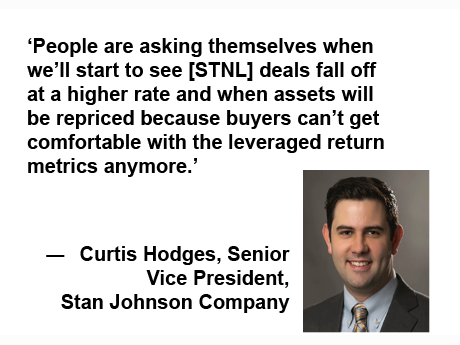The single-tenant net lease (STNL) market has enjoyed quite the ride. Rents are rising and cap rates are at or near all-time lows.
2021 was a record year for STNL transaction volume, with $103 billion in investment sales, according to Stan Johnson Company’s research, and the first quarter of 2022 has already exceeded quarter-one 2021 by more than 30 percent. At the same time, national STNL inventory has remained very constrained.
This makes it a good time to be a net lease seller.
Selling, Buying the Dream
“There is still an opportunity for sellers to take advantage of today’s pricing,” says Curtis Hodges, senior vice president in Stan Johnson Company’s Tulsa, Okla., office. “We’ve had a significant compression of cap rates over the last two years. We’re at historically peak pricing, and valuations aren’t likely to get much higher than they are today.”
Enter the first speed bump. With valuations unlikely to continue going up, sellers may not want to wait too much longer. Hodges believes we’re nearing an inflection point where pricing expectations may soon need to be adjusted.
“We’re not there yet – capital for STNL is still abundant, and there’s significant capital sitting on the sidelines,” he notes. “But we’re heading toward what might be a pricing adjustment period, perhaps by mid-year or early in 2023. I think a lot of people are asking themselves when we’ll start to see deals fall off at a higher rate and when assets will be repriced because buyers can’t get comfortable with the leveraged return metrics anymore.”
One investor group that may be more sensitive to these metrics are 1031 exchange investors. STNL transactions are notoriously popular with this cohort, but while they would enjoy the yield obtained in this uber-competitive, peak pricing market, they would need to find an asset to trade into as well.
That’s easier said than done right now. Still, with the market at a high, there’s a chance that inflection point could hit after the sale has occurred but before the new trade has closed, resulting in optimal conditions.
“If the equity from the 1031 downleg proceeds is enough to invest in the upleg property without securing high loan-to-value (LTV) debt, you’ll be able to pull the trigger on deals that those with larger financing constraints will have a tougher time with,” Hodges adds. “Those with large equity positions in STNLs who want to do a 1031 can end up in an optimal position and with more favorable pricing on their upleg than today’s peak pricing.”
Naturally, this also means cash is king once again.
“Cash buyers will remain in the market,” Hodges continues. “Especially as people sell out of this market. There are some investors that have waited patiently for this window of opportunity as well.”
Of course, peak pricing isn’t the only trend to watch in this market. Supply chain issues. Inflation. Higher costs of construction and materials. Labor shortages. Political unrest. Then you have interest rates. The Fed raised its targeted federal funds rate by 0.5 percent in early May – the largest increase in more than 20 years. With multiple rate hikes forecasted, upward pressure is expected to be placed on cap rates.
As the saying goes, however, there are opportunities — and winners — in every market. Aside from timing a 1031 exchange perfectly, Hodges believes risk can yield some, well, yield.
“A lot of people are looking at other asset types seeking a little higher yield,” he says. “This could include net leases with shorter lease terms, lesser credit, or looking at secondary markets with favorably trending demographics. You want to look at your investment risk appetite and work with a seasoned advisor in the market who can fully underwrite deals thinking about lease term, location, non-investment grade, private credit or track emerging tenant concepts.”
Emerging Winners
Hodges is particularly bullish on emerging tenant concepts that are highly convenient.
“If the business model allows for quicker stops inside the store, or allows people to not have to go into a store at all by providing a drive-thru or curbside pick-up, that concept is generally a winner,” he says.
Other STNL winners include quick service restaurant concepts like Sonic, Chipotle, Slim Chickens and Dutch Bros. Coffee, Hodges notes. These tenants are adding more drive-thru lanes, reducing or excluding sit-down space, and rapidly expanding.
“We’re seeing strong cap rates for Dutch Bros.,” Hodges adds. “In some cases, they’re selling for lower cap rates than Starbucks.”

Lanie Beck,
Stan Johnson Company
“Medtail,” the merging of healthcare and retail, is another STNL concept that’s been in the spotlight, adds Lanie Beck, director of corporate research, marketing and communications at Stan Johnson Company.
This term emerged several years ago as healthcare tenants began to occupy retail space, she says. “Urgent care facilities and dental practices, among others, started taking advantage of vacancies in shopping centers to get closer to their desired client base, and now in some cases, these tenants are embracing the single-tenant, freestanding retail format — think Aspen Dental or Clarkson Eyecare.”
The next wave of retail repurposing could be on the horizon, Beck predicts. “Drugstores like Walgreens and CVS are needing to service more and more customers through their drive-thru lanes, whether it’s for prescription pickups, testing, vaccines or urgent care services. Post-pandemic, we’re seeing significant delays and back-ups, as most of these properties only feature a single drive-thru lane.”
Beck thinks the answer could lie with vacant retail bank branches. “If drugstores, or other medical providers, had three, four, or five lanes in play at once, think how many more customers could be serviced. I could see this becoming a reality in ten-plus years.”
Where the Opportunities Lie
With many investors looking to the net lease retail market for long-term holds, it’s important for buyers to be confident in a sector, a geography and a tenant or concept before pulling the trigger.
“If you can’t buy in a primary market, then look at markets where there are favorable demographic changes happening,” says Hodges. “Lesser known secondary or tertiary markets often have plenty of strong tenants and growing concepts for investors to consider. If you study the history of the net lease market, there are opportunities today to buy properties that may see the same evolution as dollar stores 20 years ago, for example.”
So where would Hodges and Beck put their money?
“As a net lease investor, I’d look for that emerging tenant I believed in. I’d look at their business model and want to feel confident they were sustainable,” Beck says.
Hodges agrees. “Certain QSRs I personally like. I’d probably go with a well-located Dutch Bros. in a growing secondary market. They’ve figured out quick, quality service. The market’s big enough for two major specialty concepts, so they can compete with Starbucks. They’re also moving into markets where they can succeed.”
And just like that, a new winner might be born.
— Compiled by Nellie Day. This post is posted as part of Shopping Center Business’ Retail Insight series. Click here to subscribe to the Retail Insight newsletter, a four-part newsletter series, followed by video interviews delivered to your inbox in May/June.


